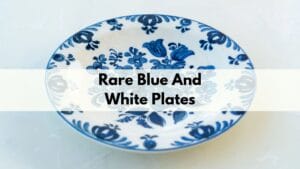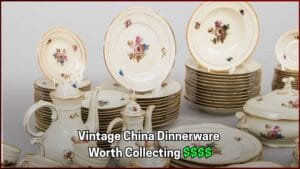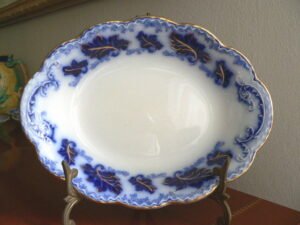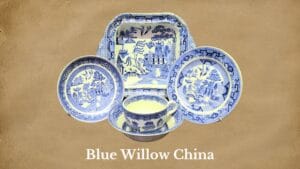Antique blue and white plates are easily any vintage dishware collector’s dream. These plates, ranging from porcelain to earthenware, featuring a vast variety of designs in cobalt blue glaze, have existed since the mid-13th century. Some of them are extremely valuable today, selling for hundreds of thousands!

So, I’ve collected the 12 rarest blue and white plates that have been selling for crazy amounts recently, you’ll also learn how to spot a valuable blue and white dish just by assessing a few factors!
1. Ming Dynasty Blue and White Plate

One of the most popular blue and white plates is the Ming Dynasty Chinese plates. These dishes feature a variety of designs; this one is a central floral medallion with a lotus or peony-like flower and alternating star/asterisk shapes and floral motifs on the border connected via vine.
Besides, this piece is marked at the bottom with the apocryphal Chenghua mark, which adds to its high value.
2. Yuan Dynasty Blue and White Dragon Plate

Dragon designs have always been most desirable on Chinese porcelain. This is an antique 14th-century Yuan Dynasty Chinese plate with stylized dragons circling around the plate rim and a Central medallion with a sectioned design.
What makes this plate rare is that the design elements, such as the dragons and different elements in the sections at the center, are made by empty white space by painting the background blue. So, the design is not blue but white.
3. 17th Century Kangxi Blue and White Plates

This rare antique blue and white Chinese plate is from the 17th-century Kangxi period. It features a hand-painted war scene with several warriors with a background of mountains and trees.
Also, the design showcases dark and light brushstrokes in different areas, a sign of hand-painted pieces. The Chinese marking at the bottom authenticates the piece and justifies its high value of $2,450!
4. Meissen Blue Onion Plate

This porcelain plate displayed Meissen’s most iconic and collectible pattern, Blue Onion, featuring a central flower arrangement with stems and blooms with a decorative border. However, what look like onions at first glance in the border design are actually onion-like flowers.
Single Onion Blue plates in good condition can easily fetch $200-$700, while sets can be valued in thousands.
5. Spode Blue Willow Plate

This Spode’s dinner plate features the classic Blue Willow pattern on a white background. The pattern includes elements like pagodas, bridges, birds, trees, and water scenes with a detailed blue border surrounding the central scene. The plate generally has a textured white scalloped edge/rim.
6. Blue Canton Export Plate

This one is a rare rectangular Export porcelain bulb or ice-cream tray with handles on each side. The center of the tray features the intricate painting of the Canton scene with pagodas, water, and trees, while the exterior features decoration of floral sprays.
7. Dutch Delft Blue and White Plates
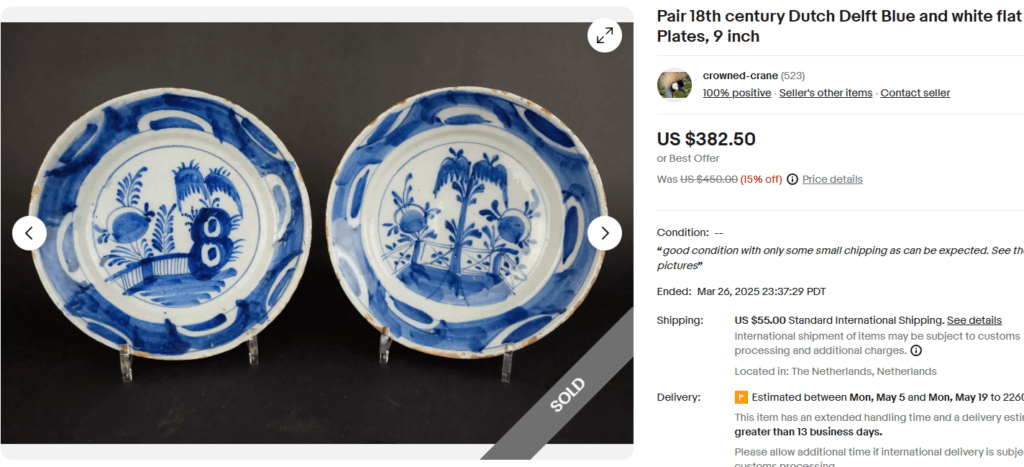
This is an example of Delftware, or the blue and white earthenware produced in the Dutch city of Delft in the 17th and 18th centuries. This set has two plates with hand-painted designs, both featuring different garden scenes with decorative elements and an uneven border.
8. Chinese Export Fitzhugh Plate

This oval-shaped large platter features the classic Fitzhugh pattern featuring bright blue floral medallions arranged around a central medallion on a white background. It’s a traditional early 19th-century Chinese export design from the Qing dynasty.
9. Royal Staffordshire Pottery Iris Flow Blue Plate

These 1900s dinner plates from Royal Staffordshire Pottery feature the Iris pattern. Like the name, the patterns showcase flowing decoration in dark and light blue (iris flowers) on the border with a generous gilding and gold trim. The center of these plates is generally white.
In good condition, these plates can fetch $80-$150 per piece, and $300-$800 per set, depending on the number of plates.
10. Royal Crown Derby Wilmot Blue White Plate

These bone china soup plates from Royal Crown Derby feature one of the company’s most collectible discontinued patterns, Wilmot Blue. The design features an intricate cobalt blue floral decoration on the border with a white center and gold trim, and the pieces will be marked “Royal Crown Derby Made in England Bone China” at the bottom.
11. Ming Dynasty Kosometsuke Plate

This is a 17th-century Ming Dynasty porcelain plate featuring a Japanese-inspired painting of a tree and a rock. The blue decoration on these plates often looks like watercolor paintings. Made during the Tianqi Period, this specific example also displays a copper red underglaze.
12. Wedgwood Ferrara Blue Plate

Made during the 19th Century, this rare Wedgwood transferware plate has the iconic Ferrara pattern. It’s known for its highly intricate and dense paintings of ships and harbor scenes in dark blue on milk white porcelain. The border surrounding the sailing ships features intricate floral scroll work.
How to Identify Valuable Blue and White Plates? (5 Key Factors to Assess)
One thing is for sure: not all vintage blue-white plates will fetch high returns; some might be worth thousands, while others, just a few bucks. So, how would you know if your dish is valuable?
Here are the 5 key factors that determine whether an old blue and white dish will be worth the money or not!
Markings & Stamps
The marks found on the bottom of china pieces are vital indicators of their makers, era, and origin. That’s why vintage blue and white dishes with original marks are considered more valuable than those without any markings.
These marks can be anything from a manufacturer’s logo, name, or symbol, date codes, or pattern names.
For instance, in Chinese porcelain dishes, reign marks (such as from the Yuan and Ming Dynasties) are quite common, while in European dishes from manufacturers like Spode, Wedgwood, and Meissen, you’ll find factory marks.

Identifying authentic marks will help you verify whether a certain old blue and white plate will be valuable or not. You can also refer to a specific maker’s marks database to differentiate between real and fake marks.
Type of Material & Painting
The material of the piece and the painting technique used to decorate the piece are also important clues to spot valuable antique blue and white dishes. Here’s how:
Quality of Porcelain:
The quality of porcelain used in the blue and white dishes impacts their worth. High-quality porcelain, which generally exhibits a pure white or subtly creamy background, is most collectible.
You can spot high-quality porcelain by looking for slight translucence, which means if you hold it up to a light source across the wall of the piece, you may see light shadows through it. Also, when gently tapped, fine porcelain typically makes a clear, ringing sound.
Painting Technique:
Blue and white dishes were generally made with two painting techniques: hand-painted or transfer painting. Generally, antique hand-painted dishes are more sought-after than transferware.
To spot hand-painted pieces, observe the decorations closely. The intensity of the blue pigment and the brushstrokes of the design show slight variations and aren’t uniform.
The Manufacturing Era & Style
Knowing the manufacturing period of an antique blue and white plate will help you find its age. It’s important because the earliest examples with hand-painted designs are the most desirable today.
The marks can be a good clue to track the age, as many makers used different marks during different periods. Similarly, different design styles were popular in specific eras, so identifying the design will also help you date the piece.
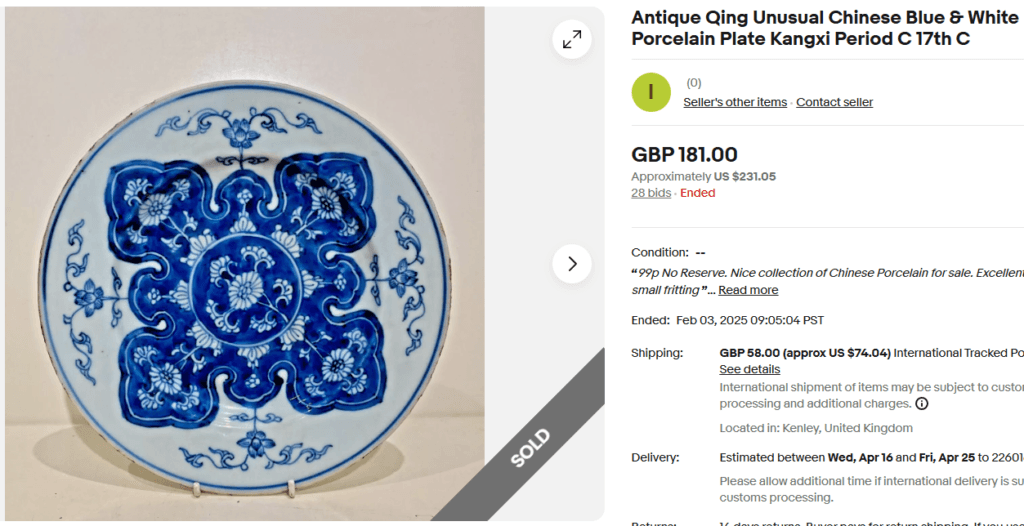
Besides, getting to know authentic antique styles, such as the Ming florals, Delft scenic landscapes, and Spode ruins, will also let you spot genuine and fake pieces.
Apart from that, if a piece has some historical significance or provenance, it can be even more valuable. For example, collectors can pay thousands for certain plates which have been commissioned or owned by renowned figures.
Condition
Needless to say, the condition plays a vital role in determining whether a blue and white plate will be worth money or not.
Plates and dishes with common damages such as cracks or hairlines (very fine cracks), chips (small pieces broken off the item), and staining or fading of the glaze are valued lowly by collectors.
However, keep in mind that certain damages are signs of natural aging and production. For example, light scratches, minimal wear on the foot rim, and glaze flaws during the firing process are generally acceptable and won’t significantly impact the value.
Shape and Size
While not a deciding factor, the shape and size of blue and white dishes do impact their value. For instance, chargers and larger plates are often more valuable than small or regular-size dinner plates.
Furthermore, collectors can pay extra money for plates in odd shapes such as scalloped rims or octagonal forms.
Note: This article is intended for informational, educational, and entertainment purposes only. Some images are illustrative and may not represent actual brands, products, or related entities. All trademarks, product names, brand logos, packaging, and other intellectual property referenced remain the exclusive property of their respective owners. Any brand mentions or references are provided solely for descriptive and educational context and do not imply any formal or commercial association.

